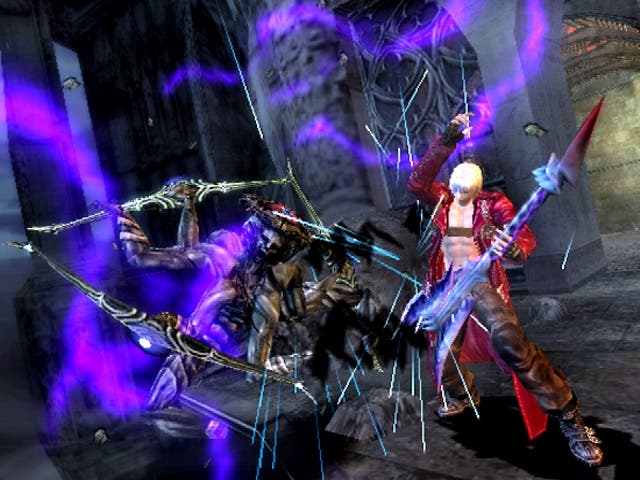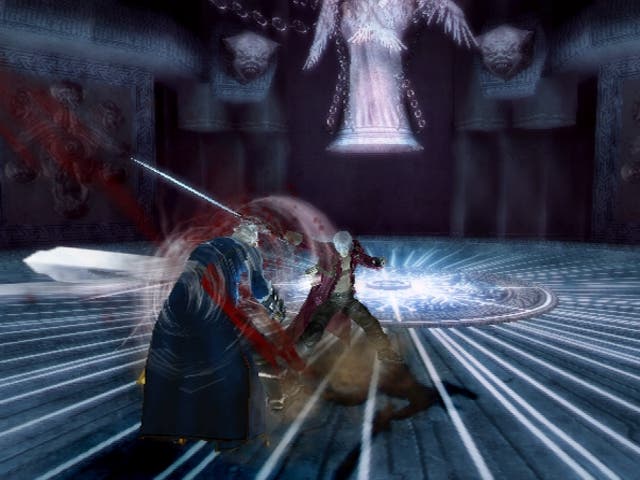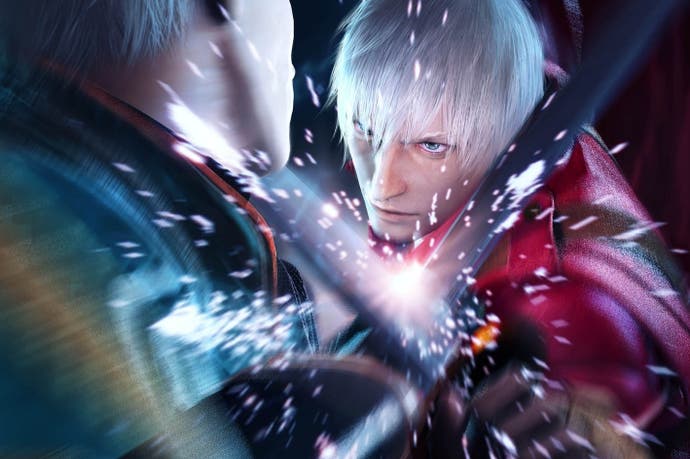Devil May Cry 3 retrospective
Dance with the devil.
There is a particular category of game - not a specific genre - that can be called endless. Tetris would be an obvious example, and at another pole there's something like Disgaea. Games where the core idea is so beautifully executed it can be escalated and repeated ad infinitum yet never loses its freshness. Things you could play forever. Devil May Cry 3 is one of the best, and despite its turbo-charged action is the ultimate slow-burner.
Your experience with a particular game always comes down to circumstance. Playing DMC 3 at the time of release, the way I thought about games was different - it seemed like a fantastic fighter, with plenty of amazing-looking locations and some of the best boss fights ever. At the same time, I unlocked Bloody Palace mode and didn't try it for weeks. No idea.
But over those weeks and months something kept me coming back, until the breakthrough. DMC3 was the first time I realised what cancelling was, and its applications took forever to sink in. Cancelling is being able to escape from a move's animation; so if Dante is swinging his sword, a specific input at a specific point can sometimes 'cancel' that animation before it finishes.

It doesn't sound like the biggest deal in the world, but it changed the way I thought about fighting games forever; if nothing else, it made me realise how terribly I'd been playing them. The whole point of cancelling is to step outside a combat system's confines. When Dante swings the frames at the end of the animation are dead time - he's recovering before the next move. Cancelling lets you circumvent this, and attack again immediately. Using Rebellion and the Royal Guard style I understood exactly that much. Then a friend introduced me to the work of Saurian.
Saurian is a fighting game expert, a guy so talented he's now contracted to make demonstration videos by developers, but at the time he was posting guides and videos of DMC3 on the ntsc-uk forum and YouTube. He co-wrote an advanced technique guide with one Lionheart about the Royal Guard style, and this was a watershed moment. Reading this gave me a feeling that I imagine could only compare to having taught yourself a song on guitar and then seeing Jimi Hendrix play it.
This thing should be a set text for any action game designer, but it's also a serious lesson for players - and not in the literal sense. It makes you realise that we sometimes slip into playing games in a narrow way; learn a technique that's successful against most of the enemies, then use it again and again. Here, the passion for experimentation runs through every line, every possibility of Dante's style stress-tested and exploited. Despite working out how to cancel moves with Royal Guard, it had never occurred to me you could also cancel with firearms (I know). These guys explore every nook and cranny of Dante's arsenal forensically, and come up with discoveries that make weapons like the Spiral, a powerful rifle with a low fire rate, entirely new propositions:
"Melee weapons are not the only things you can manipulate animation frames with. It's also possible to do the same with guns! Spiral for example in it's own right is.... it's not bad - but as soon as you unleash it in Royal Guard and G-cancel the recoil animation it's absolute carnage!" - from DMC3 Advanced Technique Guide: Royal Guard
After seeing this, who could do anything but throw themselves back into DMC3? This was when, having been spoon-fed the fact, I realised my Dante had no style; he and I were locked in repetitive patterns, so much of his potential wasted. And to give things a bit of perspective here, the Royal Guard is just one of Dante's fighting styles - there are six to choose from.
DMC3 is an endless game, and this is why. Dante is always equipped with two of five melee weapons, plus two of five sidearms, and all of these are bound up with a chosen style. Trickster's for acrobatic dodging, Swordmaster gives extra melee moves, and there are weirder styles like Quicksilver, which lets you instantly freeze time. There are so many possible combinations, and then each one has its own branching tree of attacks - and once cancelling is introduced, these branches split even more. It's a dizzying mental diagram, and gives Dante a range of expression so beyond the capabilities of most game characters it's untrue. Here's Saurian in action in the game's first fight on 'Dante Must Die' difficulty (the video's a bit rough because it's old):
DMC3 also brings into focus something special about Capcom's games, a particular expertise. DMC3 has the Bloody Palace, a bonus mode that, as with something like the Mercenaries, acts as a kind of single-player endgame. I always feel these are a through-line from the company's stellar arcade heritage. Even DMC3's greatest competitors, like Bayonetta, don't provide this, and it frees the combat system from the occasionally archaic puzzling demands and environment traversal of the campaign - an arena, basically, that has 9999 levels.
Each DMC game (barring the original) has its own twist on Bloody Palace mode, but DMC3 has random enemies and the ability to ramp up the difficulty very quickly - after clearing one floor you can go up by one, ten, or a hundred floors to the next fight. You're also limited to whatever weapon loadout you take in, and to complete Bloody Palace will take hours - it forces you to squeeze everything from what's available. Adapt or die? Not quite; you'll die loads, so it's not even worth thinking about. DMC3 is all about the former, learning this remarkable character's moves so intimately you can execute them at the speed of thought - at which point Dante becomes an irresistible avatar, one that never fails to surprise you.

Amid all the overreaction to Ninja Theory's DmC, I found myself wondering whether it was this kind of connection to a character that had inspired the rage - mastery of a beautiful system mistaken for some kind of intimacy. Why else would you so over-identify with a fictional character? It's a thought, anyway; no denying that this young Dante, in all the ways you can move and be moved by him, is exceptional.
DMC3 is a godly fighting game, and it's well to remember it came from a mistake - the terribly judged DMC2, which simplified the original's combat and put Dante in Diesel jeans. DMC3 is a prequel to the other Devil May Cry games, and that setting surely grew out of the game's initial concept; a return to 'Stylish' and difficult action.
DMC3 blossomed into something far greater - it didn't reinvent anything, but started all over again. Too many players get locked in narrow patterns of playing, and perhaps too many developers do too. DMC3 doesn't just build a brilliant combat system. It builds one that lets the player manhandle and stretch it to the limits, then adds a mode that puts you in the mixer over and over again. DMC3 is a game where every increase in skill is matched by further possibilities, a system of possibilities that often seems beyond mere mortals - and probably even Saurian. No matter how many times you complete DMC3 you'll never 'clock' it, and the hidden depths of its demon hunter are why. At the point when other games have long since drawn to a close, Dante awakens.



